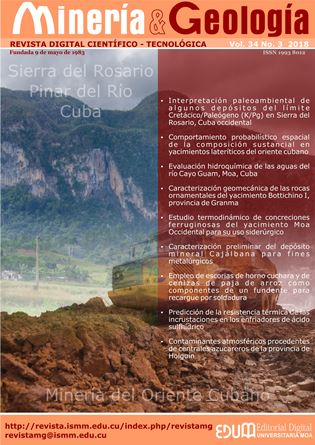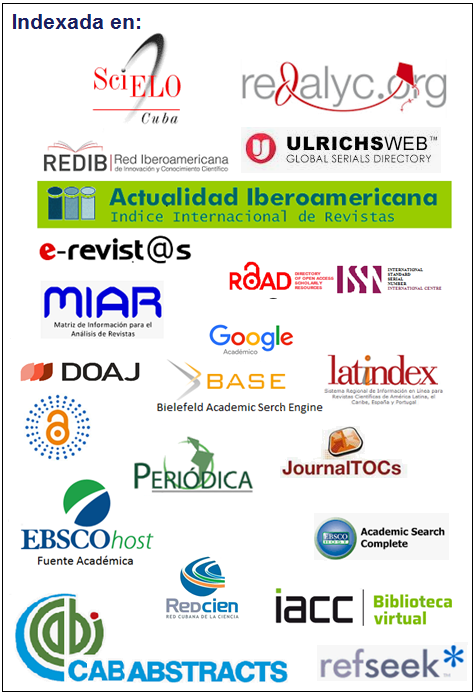Hydrochemical evaluation of the waters of the Cayo Guam River, Moa, Cuba
Keywords:
hydrochemical, water quality, Cayo Guam River, nitrites, anthropic contamination.Abstract
The watershed of the Cayo Guam River is affected by the anthropogenic activity. The purpose of this study is to evaluate the quality of waters of the river from Hydrochemical point of view. It has been taken 13 samples in total around the river bed and in different points subsequent and previous to the polluted sources. To control terrestrial waters, the values of bacteriological, physical and chemical determinations were verified taking into consideration the regulations in force. It was concluded that the main source of water pollution is the exploration and exploitation of different deposits (lateritic, chromite, aggregate) on the riverbed. From the physical point of view, the waters turned out to be weakly basic, hydrocarbon-magnesium type I and soft waters because of its hardness and low calcium contents due to the lithology of the area; its coloration exceeds what is permissible in some sampling points. The presence of nitrites that show contamination by nearby sewers was also detected; showing bacteriological contamination at the point of higher concentration of nitrites. Although the pollution values are not alarming, some elements are above the norms.Downloads
References
APHA-AWWA-WEF 1995: Standard methods for the examination of water and wasterwater. 19th edition. Washington DC, EEUU.
Mora, D. A.; Mata, A. V. y Portuguez, C. F. 2011: Calidad microbiológica de las fuentes de agua superficiales utilizadas para abastecimiento de agua potable en Costa Rica. San José (Costa Rica): Instituto Costarricense de Acueductos y Alcantarillados. 41 p. Disponible en: http://www.bvs.sa.cr/ambiente/textos/ambiente09.pdf
Chapman, D. 1996: Water quality assessment. A guide to use of biota, sediments and wáter in enviromental monitoring. 2 ed. London: UNESCO/who/unep. 626 p.
Custodio, E. 2001: Effects of groundwater development on the environment. Boletín Geológico y Minero, Madrid, 111(6): 107–120.
De Miguel, C. 2008: Hidrogeología aplicada. 2 ed. La Habana: Félix Varela. 73 p.
Mora, D. 2003. Agua para consumo humano y disposición de excretas: situación de costa rica en el contexto de américa latina y el caribe - 1960/2000. Revista Costarricense de Salud Pública, 12(21): 31-46. ISSN: 1409-1429. Disponible en: http://www.scielo.sa.cr/scielo.php
Fernández, M. 2013: Impacto ambiental por contaminación de las aguas subterráneas y superficiales en el municipio de Moa. En: Conferencia Internacional Cinarem' 2013. Moa (Cuba): Instituto Superior Minero Metalúrgico.
García, D. 2013: Análisis de los factores de degradación de los suelos en la cuenca del río Cayo Guam. Trabajo de diploma. Instituto Superior Minero Metalúrgico, Moa.
Goyenola, G. 2007: Guía para la utilización de las valijas viajeras. Red de Monitoreo Ambiental Participativo de Sistemas Acuáticos. Uruguay. Disponible en: http://imasd.fcien.edu.uy/difusion/educamb/propuestas/red/curso_2007/cartillas/1-presentacion_mapsa.pdf
Norma Cubana 827:2012: Agua potable, requisitos sanitarios. La Habana: Oficina Nacional de Normalización.
Norma Cubana 27-1999: Vertimiento de aguas residuales a las aguas terrestres y al alcantarillado. Especificaciones. La Habana: Oficina Nacional de Normalización.
Secretaría de Medio Ambiente y Recursos Naturales. 2003: Norma Oficial Mexicana Nom-Semarnat-001-1996: Establece los límites máximos permisibles de contaminantes en las descargas de aguas residuales en aguas y bienes nacionales. Diario Oficial de la Federación, 23 de abril.
Rodríguez, A. 1998: Estudio morfotectónico de Moa y áreas adyacentes para la evaluación de los riesgos de génesis tectónica. Tesis doctoral. Instituto Superior Minero Metalúrgico, Moa.
Organización Mundial de la Salud (OMS). 2004: Guías para la calidad del agua potable. 3 ed. Ginebra: OMS. 515 p.
Zhen, B. Y. 2010: Índices de calidad del agua en la microcuenca de la quebrada Victoria, Guanacaste, Costa Rica (2007-2008). Cuadernos de Investigación UNED, 2(1): 45-61. Consultado: 15 dic 2017. Disponible en: http://investiga.uned.ac.cr/revistas/index.php/cuadernos
Published
How to Cite
Issue
Section
- Authors retain copyright and guaranteeing the right magazine to be the first publication of the work as licensed under a Creative Commons Attribution-NonCommercial that allows others to share the work with an acknowledgment of the work's authorship and initial publication in this journal.
- Authors may establish separate supplemental agreements for the exclusive distribution version of the work published in the journal (eg, place it in an institutional repository or publish it in a book), with an acknowledgment of its initial publication in this journal.
- Authors are allowed and recommended to disseminate their work through the Internet (e.g., in institutional telematic archives or on their websites) before and during the submission process, which can produce interesting exchanges and increase citations of the published work. (See The effect of open access)




